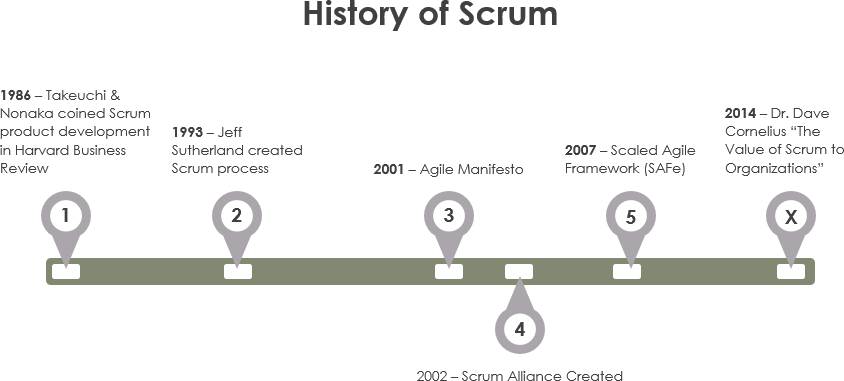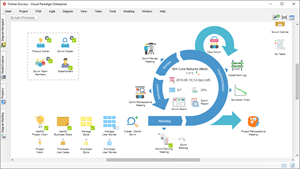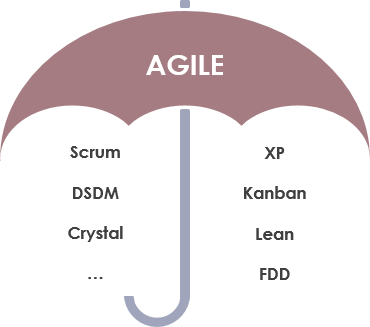A scrum (short for scrummage) is a method of restarting play in rugby that involves players packing closely together with their heads down and attempting to gain possession of the ball. Depending on whether it is in rugby union or rugby league, the scrum is utilized either after an accidental infringement or when the ball has gone out of play. Scrums occur more often, and are now of greater importance, in union than in league. Starting play from the line of scrimmage in gridiron football is derived from the scrum.

Borrowing the concept of scrum from the game of rugby, the agile approach to software development uses a scrum framework to effectively manage product development that a product development team operates as a cohesive unit working towards a common goal. In order to be successful, a Scrum team with self-organizing roles works together for a common goal, similar to a team in the game of rugby.
Much like agile scrum software development, a rugby scrum relies heavily on strong communication among team players, with each player fulfilling a specific role to the best of their abilities. When a player is unable to execute, for whatever reason, teammates are expected to step in to fill the gap. Likewise, Scrum Team members in Agile need to support and empower one another. This involves frequent communication, realistic goal setting, and an overall commitment to the team.
Agile thinking is deeply influenced by the best practices of Japanese industry, especially the lean principles promoted by Toyota and Honda, and the knowledge management strategies developed by Takeuchi Hiroyuki and Nogami Yujiro. Influenced by the above ideas and research on software projects worldwide, Jeff Sutherland first defined the Scrum process for the software development industry at Easel in 1993 and began to implement it.


Best Scrum Software Every Project Needs
A powerful scrum software that supports scrum project management. It features scrum tools like user story map, product backlog management, sprint backlog management, task management, daily scrum meeting, sprint planning tool, sprint review tool, sprint retrospective tool, burndown, impediment, stakeholder and team management.
Since the birth of the Agile Manifesto in 2001, there has much buzz around being agile. In fact, Agile approach is just a way of thinking that enables teams and organizations to innovate, quickly respond to changing demand, while mitigating risk. Organizations can be agile using many of the available frameworks available such as Scrum, Kanban, Lean, XP and etc….

Agile does not have a set of steps to follow, therefor Scrum provides a means to apply Agile to your project. Think of Scrum as a framework by which you can implement Agile development. There are many frameworks that you inherited from Agile, such as Kanban, Extreme Programming (XP) or Feature Driven Development (FDD), but the simplicity of Scrum framework make it the most popular Agile methods among all the others. Scrum can also be used as an entry point to other Agile practices. Scrum is also not solely a framework for software industry, but can benefit many other kinds of non-IT projects.
| About Visual Paradigm |
 Visual Paradigm help organizations stay competitive and responsive to change faster and better in today’s fast changing environment. Our award-winning products are trusted by over 320,000 users in companies ranging from small business, consultants, to blue chip organizations, universities and government units across the globe. It enables organizations to improve business and IT agility and foster innovation through popular open standards and process frameworks.Visual Paradigm, a killer Agile feature in 2018, introduced Scrum Process Canvas for automating the way a Scrum team to create, manage and deploy software application that empowers the team to continuously improve their performance at unprecedented speed and scale. Visual Paradigm help organizations stay competitive and responsive to change faster and better in today’s fast changing environment. Our award-winning products are trusted by over 320,000 users in companies ranging from small business, consultants, to blue chip organizations, universities and government units across the globe. It enables organizations to improve business and IT agility and foster innovation through popular open standards and process frameworks.Visual Paradigm, a killer Agile feature in 2018, introduced Scrum Process Canvas for automating the way a Scrum team to create, manage and deploy software application that empowers the team to continuously improve their performance at unprecedented speed and scale.
Manage the Entire Scrum Process in One Page
|